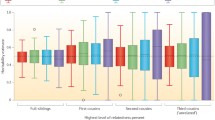Abstract
Cryptic relationships such as first-degree relatives often appear in studies that collect population samples, including genome-wide association studies (GWAS) and next-generation sequencing (NGS) analyses. Cryptic relatedness not only increases type 1 error rate of association tests but also affects other analytical aspects of GWAS and NGS such as population stratification via principal component analysis. Here, we discuss three effective methods, as implemented in PREST, PLINK, and KING, to detect and correct for the problem of cryptic relatedness using high-throughput SNP data collected from GWAS and NGS experiments. We provide the analytical and practical details involved using three application examples.
Similar content being viewed by others
References
Voight BF, Pritchard JK (2005) Confounding from cryptic relatedness in case-control association studies. PLoS Genet 1(3):e32
Thornton T, McPeek MS (2010) Roadtrips: case-control association testing with partially or completely unknown population and pedigree structure. Am J Hum Genet 86(2):172–184
Price AL, Zaitlen NA, Reich D, Patterson N (2010) New approaches to population stratification in genome-wide association studies. Nat Rev Genet 11:459–463
McPeek MS, Sun L (2000) Statistical tests for detection of misspecified relationships by use of genome-screen data. Am J Hum Genet 66(3):1076–1094
Dimitromanolakis A, Paterson AD, Sun L (2009) Accurate IBD inference identifies cryptic relatedness in 9 hapmap populations. Abstract no. 1768 presented at the annual meeting of the American Society of Human Genetics.
Sun L, Wilder K, McPeek MS (2002) Enhanced pedigree error detection. Hum Hered 54(2):99–110
Purcell S, Neale B, Todd-Brown K, Thomas L, Ferreira MAR, Bender D, Maller J, Sklar P, de Bakker PIW, Daly MJ, Sham PC (2007) Plink: a tool set for whole-genome association and population-based linkage analyses. Am J Hum Genet 81(3):559–575
Manichaikul A, Mychaleckyj JC, Rich SS, Daly K, Sale M, Chen WM (2010) Robust relationship inference in genome-wide association studies. Bioinformatics 56(22):2867–2873
Chen WM, Manichaikul A, Rich SS (2016) KING 2.0: relationship inference and integrated analysis in one million samples. Abstract #365T presented at the American Society of Human Genetics annual meeting
The International HapMap Consortium (2007) A second generation human haplotype map of over 3.1 million snps. Nature 449(7164):851–861
Begleiter H, Reich T, Nurnberger JJ, Li TK, Conneally PM, Edenberg H, Crowe R, Kuperman S, Schuckit M, Bloom F, Hesselbrock V, Porjesz B, Cloninger CR, Rice J, Goate A (1999) Description of the genetic analysis workshop 11 collaborative study on the genetics of alcoholism. Genet Epidemiol 17(Suppl 1):S25–S30
Antoni G, Morange P, Luo Y, Saut N, Burgos G, Heath S, Germain M, Biron-Andreani C, Schved J, Pernod G, Galan P, Zelenika D, Alessi M, Drouet L, Visvikis-Siest S, Wells P, Lathrop M, Emmerich J, Tregouet D, Gagnon F (2010) A multi-stage multi-design strategy provides strong evidence that the bai3 locus is associated with early-onset venous thromboembolism. J Thromb Haemost 8(12). doi:10.1111/j.1538-7836.2010.04092.x
Browning SR, Browning BL (2010) High-resolution detection of identity by descent in unrelated individuals. Am J Hum Genet 86(4):526–539
Author information
Authors and Affiliations
Corresponding author
Editor information
Editors and Affiliations
Rights and permissions
Copyright information
© 2017 Springer Science+Business Media LLC
About this protocol
Cite this protocol
Sun, L., Dimitromanolakis, A., Chen, WM. (2017). Identifying Cryptic Relationships. In: Elston, R. (eds) Statistical Human Genetics. Methods in Molecular Biology, vol 1666. Humana Press, New York, NY. https://doi.org/10.1007/978-1-4939-7274-6_4
Download citation
DOI: https://doi.org/10.1007/978-1-4939-7274-6_4
Published:
Publisher Name: Humana Press, New York, NY
Print ISBN: 978-1-4939-7273-9
Online ISBN: 978-1-4939-7274-6
eBook Packages: Springer Protocols




